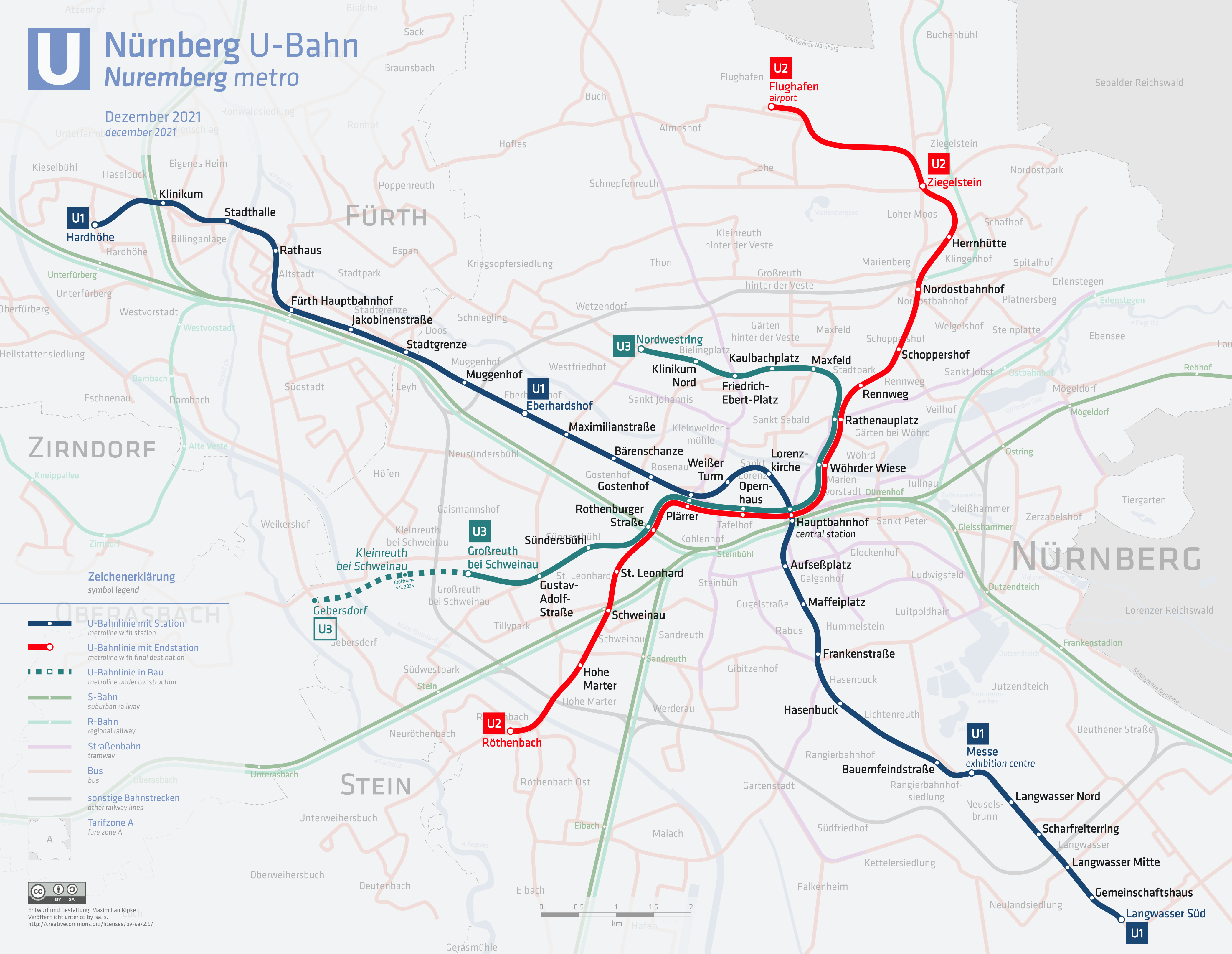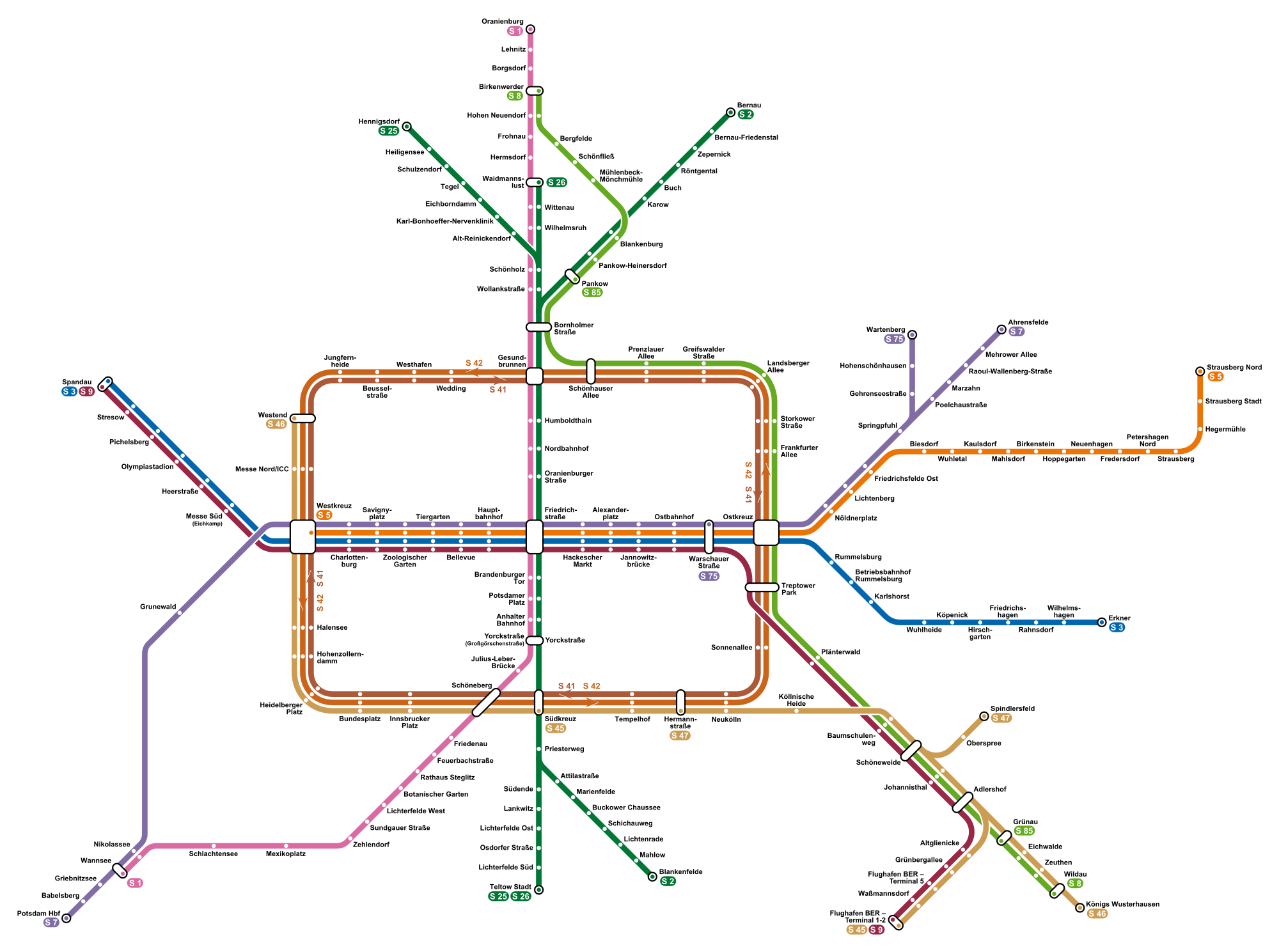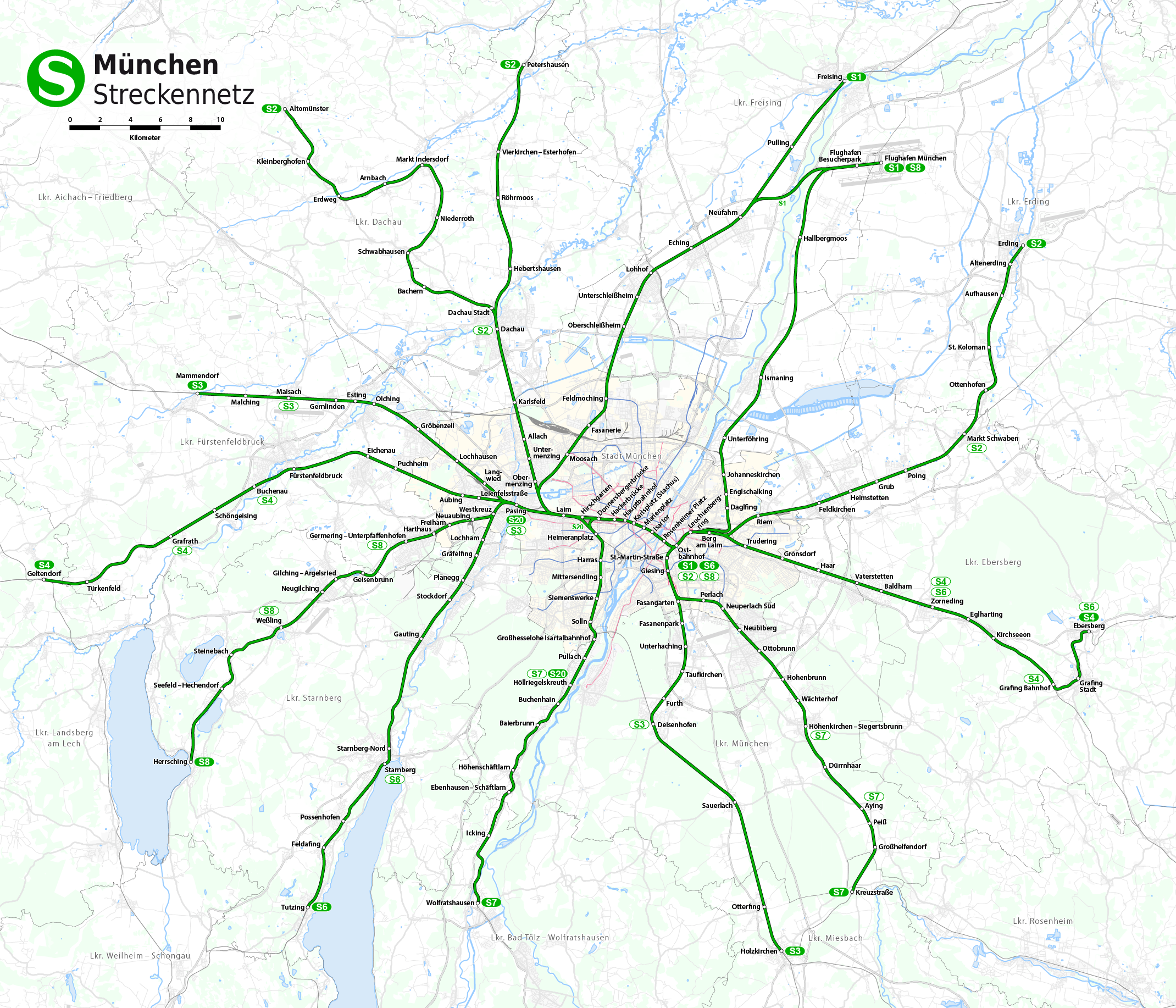|
U-Bahn
Rapid transit in Germany consists of four U-Bahn systems and fourteen S-Bahn systems. The U-Bahn commonly understood to stand for Untergrundbahn (''underground railway'') are conventional rapid transit systems that run mostly underground, while the S-Bahn or Stadtschnellbahn (''city rapid railway'') are commuter rail services, that may run underground in the city center and have metro-like characteristics in Munich, Hamburg and Berlin which they only have to a lesser extent in other cities. There are also over a dozen premetro or Stadtbahn systems that are rapid transit in the city center and light rail outside. There are four U-Bahn systems, namely in Berlin, Hamburg, Munich and Nuremberg; these are all run by the transit authorities in the city. Some cities call their Stadtbahn "U-Bahn" (like Frankfurt) or abbreviate their Stadtbahn with a U. The confusing term "U-Stadtbahn" is also used on occasion and as "U-Bahn" is often seen as the more desirable term, common parlance ... [...More Info...] [...Related Items...] OR: [Wikipedia] [Google] [Baidu] |
Munich U-Bahn
The Munich U-Bahn (german: U-Bahn München) is an electric rail rapid transit network in Munich, Germany. The system began operation in 1971, and is operated by the municipally owned Münchner Verkehrsgesellschaft (MVG; Munich Transport Company). The network is integrated into the Münchner Verkehrs- und Tarifverbund (MVV; Munich Transport and Tariff Association) and interconnected with the Munich S-Bahn. The U-Bahn currently comprises eight lines, serving 96 stations (100 stations if four interchange stations with separate levels for different lines are counted twice), and encompassing of routes. Current routes There are eight lines: The network has of active route, and 100 stations. In 2014, 390 million passengers rode the U-Bahn. The trains operate at speeds up to , which is the top speed among German U-Bahns. There is no continuous operation during the night (break from 1 to 4 am, 2 to 4 am on weekends) except on special occasions such as New Year's Eve. Currently, ... [...More Info...] [...Related Items...] OR: [Wikipedia] [Google] [Baidu] |
Berlin U-Bahn
The Berlin U-Bahn (; short for , "underground railway") is a rapid transit system in Berlin, the capital and largest city of Germany, and a major part of the city's public transport system. Together with the S-Bahn, a network of suburban train lines, and a tram network that operates mostly in the eastern parts of the city, it serves as the main means of transport in the capital. Opened in 1902, the serves 175 stations spread across nine lines, with a total track length of , about 80% of which is underground. Trains run every two to five minutes during peak hours, every five minutes for the rest of the day and every ten minutes in the evening. Over the course of a year, U-Bahn trains travel , and carry over 400 million passengers. In 2017, 553.1 million passengers rode the U-Bahn. The entire system is maintained and operated by the , commonly known as the BVG. Designed to alleviate traffic flowing into and out of central Berlin, the U-Bahn was rapidly expanded until the city ... [...More Info...] [...Related Items...] OR: [Wikipedia] [Google] [Baidu] |
Hamburg U-Bahn
The Hamburg U-Bahn is a rapid transit system serving the cities of Hamburg, Norderstedt and Ahrensburg in Germany. Although referred to by the term U-Bahn (the "U" commonly being understood as standing for "underground"), most of the system's track length is above ground. The network is interconnected with the city's S-Bahn system, which also has underground sections. It is operated by Hamburger Hochbahn within the Hamburger Verkehrsverbund (HVV). It was opened in February 1912, and comprises four lines serving 93 stations, with a route length of in 2019. History In 1906 the Senate of Hamburg awarded a contract for the Elevated and Underground Railway to Siemens & Halske and AEG of Berlin. The first stretch was completed on 7 October 1906. This was followed in 1911 with the founding of the ''Hamburger Hochbahn Aktiengesellschaft'' (HHA). Thus Hamburg became the third German city (after Berlin, 1902 and Schöneberg, 1910) to have a U-Bahn (then known as the Elevated and Unde ... [...More Info...] [...Related Items...] OR: [Wikipedia] [Google] [Baidu] |
Nuremberg U-Bahn
The Nuremberg U-Bahn is a rapid transit system run by '' Verkehrs-Aktiengesellschaft Nürnberg'' (VAG; Nuremberg Transport Corporation), which itself is a member of the '' Verkehrsverbund Großraum Nürnberg'' (VGN; Greater Nuremberg Transport Network). The Nuremberg U-Bahn is Germany's newest metro system, having begun operation in 1972, although the Nuremberg-Fürth route (U1) uses part of the right of way of the Bavarian Ludwig Railway, Germany's first passenger railway opened in 1835. The current network of the U-Bahn is composed of three lines, serving 49 stations, and comprising of operational route, making it the shortest of the four metro systems in Germany, behind Berlin, Hamburg and Munich. In 2008, driverless and fully automated trains were introduced on the new U3 line, making it Germany's first automatic U-Bahn line. History Plans for a metro in Nuremberg go back to 1925, when Nuremberg graduate engineer Oscar Freytag spoke out in favor of building a metro under ... [...More Info...] [...Related Items...] OR: [Wikipedia] [Google] [Baidu] |
Stadtbahn
' (; German for "city railway"; plural ') is a German word referring to various types of urban rail transport. One type of transport originated in the 19th century, firstly in Berlin and followed by Vienna, where rail routes were created that could be used independently from other traffic. In the 1960s and 1970s ''Stadtbahn'' networks were created again but now by upgrading tramways or light railways. This process includes adding segments built to rapid transit standards –usually as part of a process of conversion to a metro railway– mainly by the building of metro-grade tunnels in the central city area. In the first years after the opening of the tunnel sections, often regular trams vehicles (but adapted for tunnel service) were used. These trams were followed by specially designed vehicles like the Stadtbahn B series. By the 1980s virtually all cities had abandoned the long-term goal of establishing a full-scale metro system due to the excessive costs associated with conv ... [...More Info...] [...Related Items...] OR: [Wikipedia] [Google] [Baidu] |
Berlin S-Bahn
The Berlin S-Bahn () is a rapid transit railway system in and around Berlin, the capital city of Germany. It has been in operation under this name since December 1930, having been previously called the special tariff area ''Berliner Stadt-, Ring- und Vorortbahnen'' (Berlin city, orbital, and suburban railways). It complements the Berlin U-Bahn and is the link to many outer-Berlin areas, such as Berlin Brandenburg Airport. As such, the Berlin S-Bahn blends elements of a commuter rail service and a rapid transit system. In its first decades of operation, the trains were steam-drawn; even after the electrification of large parts of the network, a number of lines remained under steam. Today, the term ''S-Bahn'' is used in Berlin only for those lines and trains with third-rail electrical power transmission and the special Berlin S-Bahn loading gauge. The third unique technical feature of the Berlin S-Bahn, the , is being phased out and replaced by a communications-based train contro ... [...More Info...] [...Related Items...] OR: [Wikipedia] [Google] [Baidu] |
Berlin
Berlin is Capital of Germany, the capital and largest city of Germany, both by area and List of cities in Germany by population, by population. Its more than 3.85 million inhabitants make it the European Union's List of cities in the European Union by population within city limits, most populous city, as measured by population within city limits having gained this status after the United Kingdom's, and thus London's, Brexit, departure from the European Union. Simultaneously, the city is one of the states of Germany, and is the List of German states by area, third smallest state in the country in terms of area. Berlin is surrounded by the state of Brandenburg, and Brandenburg's capital Potsdam is nearby. The urban area of Berlin has a population of over 4.5 million and is therefore the most populous urban area in Germany. The Berlin/Brandenburg Metropolitan Region, Berlin-Brandenburg capital region has around 6.2 million inhabitants and is Germany's second-largest metropolitan reg ... [...More Info...] [...Related Items...] OR: [Wikipedia] [Google] [Baidu] |
Hamburg S-Bahn
The Hamburg S-Bahn is a suburban commuter railway network in the Hamburg Metropolitan Region. Together, the S-Bahn, the Hamburg U-Bahn, the AKN railway and the regional railway form the backbone of railway public transport in the city and the surrounding area. The network has operated since 1907 as a commuter rail system, under the direction of the state railway, and is a member of the Hamburger Verkehrsverbund (HVV; Hamburg Transport Association). There are six lines, serving 68 stations, on of route. On an average working day the S-Bahn transports about 590,000 passengers; in 2010 about 221 million people used the S-Bahn. The S-Bahn is the only railway in Germany that uses both 1,200 V DC supplied by a third rail and supplied by overhead lines. Most of the tracks are separated from other rail services. The S-Bahn is operated by S-Bahn Hamburg GmbH, a subsidiary of DB Regio. Similarly to Berlin but unlike Hanover, the S-Bahn is an important part of public transport wit ... [...More Info...] [...Related Items...] OR: [Wikipedia] [Google] [Baidu] |
Nuremberg S-Bahn
The Nuremberg S-Bahn (german: S-Bahn Nürnberg) is an S-Bahn network covering the region of Nuremberg, Fürth and Erlangen which started operations in 1987 and is now integrated into the Greater Nuremberg Transport Association ( Verkehrsverbund Großraum Nürnberg). The full length of the five current lines is about 277.6 kilometres. The S-Bahn trains are operated by DB Regio Mittelfranken, a subsidiary of DB Regio Bayern. From December 2018 the service was due to be taken over by National Express Germany, however it withdrew from the bidding process on 25 October 2016, so the lines will continue to be operated by DB Regio Mittelfranken for the foreseeable future. The service between Fürth and Erlangen-Bruck has been marred by frequent delays and service restrictions due to the slow construction for four-track expansion. No completion date is given. The original plans for the upgrade of the Nuremberg Bamberg line to four tracks called for a new alignment of S-Bahn tracks east o ... [...More Info...] [...Related Items...] OR: [Wikipedia] [Google] [Baidu] |
Hamburg
Hamburg (, ; nds, label=Hamburg German, Low Saxon, Hamborg ), officially the Free and Hanseatic City of Hamburg (german: Freie und Hansestadt Hamburg; nds, label=Low Saxon, Friee un Hansestadt Hamborg),. is the List of cities in Germany by population, second-largest city in Germany after Berlin, as well as the overall List of cities in the European Union by population within city limits, 7th largest city and largest non-capital city in the European Union with a population of over 1.85 million. Hamburg's urban area has a population of around 2.5 million and is part of the Hamburg Metropolitan Region, which has a population of over 5.1 million people in total. The city lies on the River Elbe and two of its tributaries, the River Alster and the Bille (Elbe), River Bille. One of Germany's 16 States of Germany, federated states, Hamburg is surrounded by Schleswig-Holstein to the north and Lower Saxony to the south. The official name reflects History of Hamburg, Hamburg's history ... [...More Info...] [...Related Items...] OR: [Wikipedia] [Google] [Baidu] |
S-Bahn Berlin Baureihe 481
The S-Bahn is the name of hybrid urban-suburban rail systems serving a metropolitan region in German-speaking countries. Some of the larger S-Bahn systems provide service similar to rapid transit systems, while smaller ones often resemble commuter or even regional rail. The term derives from ''Schnellbahn'', ''Stadtbahn'' or ''Stadtschnellbahn''. Similar systems in Switzerland are known as S-Bahn as well. In Belgium it is known as S-Trein (Flemish) or Train S (French). In Belgium there are S-Trains in the five largest cities: Brussels, Antwerp, Liège, Ghent and Charleroi. In Denmark, they are known as S-tog , in the Czech Republic as Esko or S-lines. Characteristics There is no complete definition of an S-Bahn system. S-Bahn are, where they exist, the most local type of railway stopping at all existing stations inside and around a city, while other mainline trains only call at major stations. They are slower than mainline railways but usually serve as fast crosstown ... [...More Info...] [...Related Items...] OR: [Wikipedia] [Google] [Baidu] |
Munich S-Bahn
The Munich S-Bahn (german: S-Bahn München) is an electric rail transit system in Munich, Germany. "S-Bahn" is the German abbreviation for ''Stadtschnellbahn'' (literally, "urban rapid rail"), and the Munich S-Bahn exhibits characteristics of both rapid transit and commuter rail systems. The Munich S-Bahn network is operated by S-Bahn München, a subsidiary of DB Regio Bayern, which is itself a subsidiary of the German national railway company, Deutsche Bahn. It is integrated into the Munich Transport and Tariff Association (''Münchner Verkehrs- und Tarifverbund'', MVV) and interconnected throughout the city with the locally owned Munich U-Bahn. Today, the S-Bahn covers most of the populated area of the Munich metropolitan area of about 2.7 million inhabitants. The Munich S-Bahn was established on 28 May 1972. It was intended as part of the scheme to provide an adequate transport system during the 1972 Summer Olympics held in Munich by connecting the pre-existing suburban rail s ... [...More Info...] [...Related Items...] OR: [Wikipedia] [Google] [Baidu] |

.jpg)





